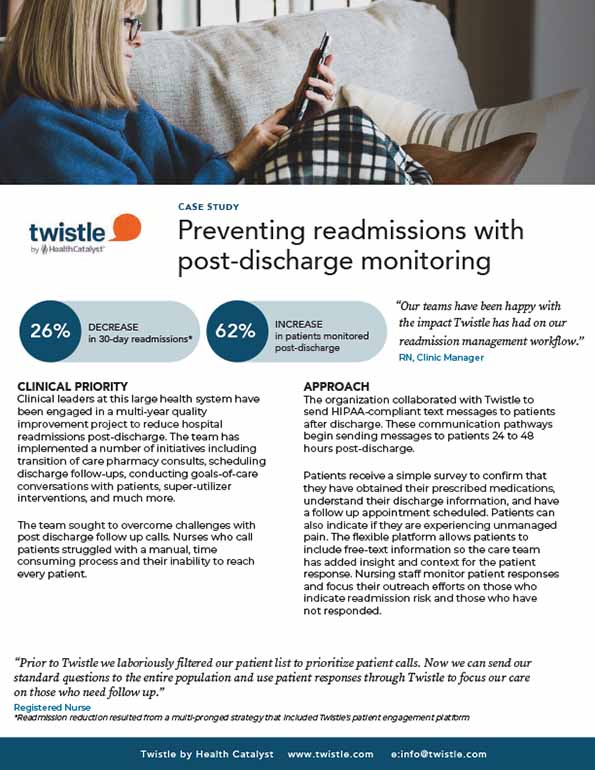This large health system utilized Twistle by Health Catalyst to streamline its post-discharge follow up with patients, improving patient outreach post-discharge and decreasing readmissions.
Clinical leaders at this large health system have been engaged in a multi-year quality improvement project to reduce hospital readmissions post-discharge. The team has implemented a number of initiatives, including transition of care pharmacy consults, scheduling discharge follow-ups, conducting goals of care conversations with patients, super-utilizer interventions, and much more.
The team sought to overcome challenges with post discharge follow up calls. Nurses who call patients struggled with a manual, time consuming process and their inability to reach every patient.
The organization collaborated with Twistle by Health Catalyst to send HIPAA-compliant text messages to patients after discharge. These communication pathways begin sending messages to patients 24 to 48 hours post-discharge.
Patients receive a simple survey to confirm that they have obtained their prescribed medications, understand their discharge information, and have a follow-up appointment scheduled. Patients can also indicate if they are experiencing unmanaged pain. The flexible platform allows patients to include free-text information so the care team has added insight and context for the patient response. Nursing staff monitor patient responses and focus their outreach efforts on those who indicate readmission risk and those who have not responded.
"Our teams have been happy with the impact Twistle has had on our readmission management workflow."
- RN, Clinic Manager
The team implemented Twistle’s post-discharge pathway to reach patients being discharged to home or with home health; those being discharged to hospice or a skilled nursing facility are excluded.
To measure the impact of the program, the organization evaluated call volumes, staff efficiency, and readmission rates.
“Prior to Twistle we laboriously filtered our patient list to prioritize patient calls. Now we can send ourstandard questions to the entire population and use patient responses through Twistle to focus our care on those who need follow up.”
- RN
“Thank you for this kind and thoughtful text and the excellent care I received from each and every human being on your staff in my recent stay. The professionalism and attention with massive doses of courtesy, compassion, care, patience, and friendliness I will always remember.”
- Patient enrolled in Twistle
The health system has been able to streamline its post-discharge follow up with patients so that a wider patient population is being reached and nurses are able to focus outreach on the most vulnerable patients. Nursing staff experience more efficient patient calls, focusing on the patient’s specific care needs, and have effected a measurable reduction in readmissions.


